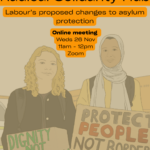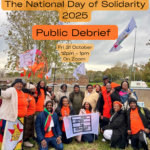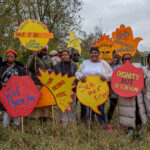As LGBT History Month draws to a close, it seems timely to review the progress – and lack of it – in the treatment of asylum claims in the UK on the basis of sexuality.
Asylum claims based on sexual identity first came under recognised refugee protection in the UK in 1999 – nearly 50 years after the 1951 Refugee Convention came into force.
HJ/HT
An important milestone was 2010, with the Supreme Court ruling in the case of HJ (Iran) and HT (Cameroon) – one case, involving two linked asylum claims.
Before this ruling, the UK Home Office could, perfectly lawfully, tell LGBT+ asylum seekers that they were not in need of protection in the UK under the Refugee Convention because they could return to their country, hide their sexuality, and therefore be safe from persecution.
This was clearly at odds with the way that, for example, people claiming asylum on the basis of political opinion were treated. If someone was a member of a political opposition group, they were not expected to return home and hide those beliefs and activity.
In this case – HJ Iran) and HT Cameroon – the judges said that:
“To compel a homosexual person to pretend that his sexuality does not exist or suppress the behaviour by which to manifest itself is to deny his fundamental right to be who he is.”
Since the ruling, the approach in deciding asylum claims based on sexuality should be as follows:
- Is the asylum seeker gay, or someone who would be treated as gay by potential persecutors in their home country?
- Do openly gay individuals in the country of origin face a well-founded fear of persecution. (Read more about the definition of persecution in our Toolkit here).
- How would the asylum seeker actually live if returned? If they would live openly, then clearly they are a refugee.
- If they would live “discreetly”, why will they exercise “discretion”? If it is simply to avoid social pressure, family shame, or some discrimination, then they do not qualify for refugee protection in the UK. But if a fear of persecution plays any material part in the decision to hide, then the asylum seeker is a refugee.
Remember this last point.
A change in tactics from the Home Office
After this ruling, the Home Office tried a new approach in dealing with asylum claims based on sexuality. If saying, ‘go home and go back in the closet’ no longer seemed like an option, they instead (with remarkable consistency) told the asylum seeker that they didn’t believe they were gay.
As Paul Dillane wrote in this piece for the Free Movement legal blog:
“[After the 2010 ruling], the battle shifted to disbelief: unhelpful and false stereotypes prevailed and claimants frequently subjected to humiliating and bizarre questions.”
Asylum seekers were routinely asked intrusive questions about their sexual behaviour, despite sexuality being about identity rather than behaviour. The Free Movement blog post shared an example of an asylum interview with a bisexual asylum seeker, in which they were subjected to over 220 questions. A document leaked to the Observer newspaper in 2014 revealed appalling examples of this intrusive and explicit questioning:
“Did you put your penis into x’s backside?” and “When x was penetrating you, did you have an erection? Did x ejaculate inside you. Why did you use a condom?”
‘Proving’ sexuality
While the UN Refugees Agency (UNHCR) guidelines are very clear that “Applicants should never be expected or asked to bring in documentary or photographic evidence of intimate acts” many asylum seekers felt pressured to provide explicit material in the face of unyielding disbelief about their sexual orientation.
In December 2014 the case of ABC at the European Court of Justice provided binding guidance as a matter of EU law on prohibited methods of investigating an asylum claim, including the viewing of sexually explicit material.
The leading LGBT+ asylum barrister S Chelvan developed an alternative model of approaching sexuality asylum claims called the Difference, Stigma, Shame, Harm (DSSH) model. This model is a sensitive and appropriate way of assessing credibility, of eliciting a detailed narrative that provides the evidence to establish that someone is a gay refugee. Find out more about this on our legal blog here.
Improved guidance?
In February 2015, the Home Office issued new asylum policy guidance on sexual identity issues in asylum interviews.
The guidance seemed to address the widely-publicised concerns about explicit and intrusive questioning:
“The interview should be a sensitive enquiry into the development and exploration of the claimant’s sexual identity and the extent to which it is relevant to the assessment of the need for protection. It should not be an enquiry into any explicit sexual activity… [There are] no circumstances in which it will be appropriate for the interviewer to instigate questions of a sexually explicit nature. This includes questions about explicit sexual activity or physical attraction.”
Read more about the guidance in our legal blog post here.
Although the guidance seemed to a positive step forward, significant problems in the conduct of asylum interviews remain.
As recently as November 2016, it was revealed that the Home Office quizzed a bisexual asylum seeker from Pakistan about LGBT terminology. The Home Office interviewer went on to say “Okay, so considering that you claim to have been at the London Pride event, and you are going to the Big Weekend event also for the LGBT community, how is it that you incorrectly refer to the T in LGBT as trans, when it in fact means transgender?”. Read more in Pink News here.
The discretion loophole
Remember that last point of the approach following HJ/HT? About ‘choosing’ to be discreet on return? We saw rather more of that we had hoped.
Right to Remain was in touch with an asylum seeker who was told by the judge that his reason for hiding his sexuality on return would not be due to fear of persecution, but that he was clearly a quiet and discreet individual (based on the man’s appearance in the often terrifying experience of an asylum appeal).
Both the Home Office and courts seemed to be able to tell an asylum seeker that they would choose to be discreet because of societal or family reasons, rather than the fact they were from a rabidly homophobic country where being openly gay could lead to serious mistreatment, persecution and even death.
Case law since HJ/HT should have closed this loophole. The July 2015 case “MSM (journalists; political opinion; risk) Somalia” highlighted that in EU law there is no room for a person to avoid persecution by voluntary modification of conduct or voluntary discretion.
Despite this, the Home Office issued Asylum Policy Instructions in August 2016 that clung on to the discretion loophole. This position is reiterated in the January 2017 Country Policy and Information Note on Afghanistan: Sexual orientation and Gender Identity.
It it this latest guidance on Afghanistan that was reported on in the Guardian over the weekend: Deported gay Afghans told to ‘pretend to be straight’.
As the article points out, homosexuality is illegal in Afghanistan and “not a single citizen lives an openly gay life.”
The discretion question will be considered as a point of law at the Court of Appeal in April, in a case called LC (Albania).
In the meantime, LGBT+ asylum seekers still face huge obstacles in having their need for protection recognised, and suffer many indignities as they try to navigate the UK’s hostile asylum process.
LGBT+ asylum seekers in UK face "Discrimination, disbelief and indefinite detention.That must change" says @Paul_Dillane #NoSafeRefuge #LGBT
— Lisa Matthews (@LisaMatthewsRtR) February 27, 2017
You can find out more about the indefinite detention of LGBT+ asylum seekers in the report launched by Stonewall and the UK Lesbian and Gay Immigration group last night: No Safe Refuge.
















Discussion: